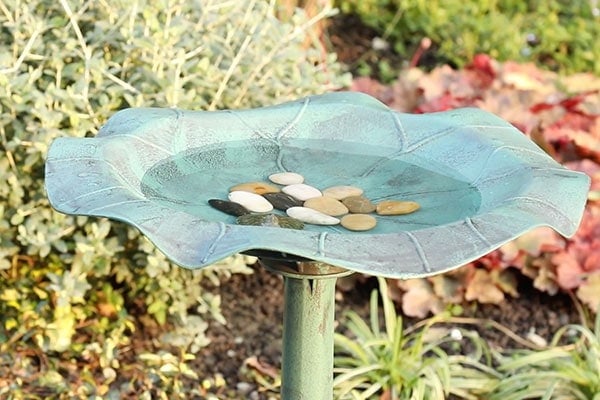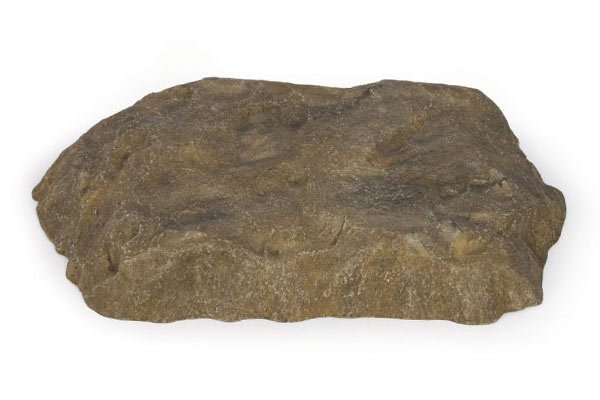Is putting stones in a bird bath a necessity? Many birdwatching aficionados tend to add them to their gorgeous baths – and your inquisitive mind continues to wonder… why do you put stones in a bird bath. Do not drive yourself bananas attempting to figure it out because I’m going to reveal the absolute truth here today.
Adding stones to a bird bath adds more beauty and zest to an already wonderful design. But they also serve an even greater purpose. Submerging them in your basin gives winged wildlife a place to perch while they clean off or take a drink. These stones are ideal because they aren’t slippery and offer birds a nice place to stand as they complete their birdy business.
And we’re just getting started with our discussion. Other related information to look forward to includes:
- The truth behind placing stones in bird baths
- The best types of stones for bird baths
- Eliminate water level depth issues with pebbles or stones
- Are large, flat rocks more attractive to smaller birds?
- Bird bath safety tips to keep birds happy and healthy
Now it’s time to discover the truth in greater detail…
Bird Bath Stones: The Ultimate Reasons Why They’re A Must

In some cases, you’ll benefit tremendously by adding stones or pebbles to the bottom of your bird bath. But many of you likely have no idea why they’re so beneficial.
Some of the reasons include:
- They prevent birds from slipping or sliding on a slick bird bath basin
- They make a great perch for birds that want to clean themselves without being submerged in water
- They add extra style and pizzazz to your otherwise attractive birdbath
- They help attract smaller birds
- They make the water level in deep basins shallower, which makes it easier for the birds to clean themselves or take a drink
As you can see, stones actually play a major role in whether or not your bird bath is successful. If you do not make it appealing enough to the birds, they will avoid your backyard bath altogether. And that certainly defeats the purpose of placing one in your backyard in the first place.
Ultimately, the best reason to add pebbles or stones to your bird bath is to keep the birds safe, healthy, and happy. Some bath basins are made of ceramic or slick resin. Although sturdy and strong, the materials used to create these basins are potentially hazardous to small and fragile birds.
That’s why stones come into the picture. You’ll do the local birds in your neighborhood a great service by providing stones in your bath. And you’ll attract many more of your favorites in the process.
Related reading:
- Buyers Guide To Select The Best Solar Bird Baths
- The Definitive Guide To Buying Bird Baths
- A Review Of The Best Heated Bird Baths You Can Buy
What Are The Best Types Of Stones For Bird Baths?
Some types of stones are much better than others. My personal favorites and recommendations from other bird bath experts include the following:
- Large flat rocks – this type of stone is an excellent choice because it provides a large area within the bird bath for the birds to stand on. Why is this important? It gives them a place to properly clean themselves without being totally submerged in the water. And it’s an excellent spot for a bird to submerge their head into the water to take a drink without falling in.
- Pea gravel – this style of gravel is an excellent choice because it’s made up of rounded stones and chipped stones that are roughly the same size as a pea. That’s why they were given this name. These stones are natural, attractive, and easy to walk on and they also prevent birds from slipping on a slick concrete or stone basin.
- Pebbles – sometimes pebbles are smooth and other times they’re coarser and more jagged. The great thing about adding pebbles to a bird bath is they’re small enough for multi-sized birds to grab hold of, walk on, and maintain good footing without slipping or unintentionally falling over.
- Large pointed rocks – you may also want to add a large pointed rock or two to the bird bath. This type of rock will stick up out of the water and create a nice perch that birds would enjoy sitting on as they look over the bath and watch the activity of the other birds taking place within.
All of these stones make excellent choices. Try not to limit yourself in any way. If you want to add decorative or colorful stones for aesthetic appeal, that’s certainly acceptable as well as long as they aren’t slippery.
Water Level Depth Troubles: How To Eliminate This Issue Once & For All
Did you know that birds prefer shallow bird baths? Most people think a deeper bath is exactly what the doctor ordered, but nothing could be further from the truth.
Why is that?
Well, smaller backyard birds are used to cleaning themselves and drinking water from puddles that accumulate on the ground. This is a far cry from swimming in a large pond or other bigger bodies of water.
And it makes sense, right?
These little birds have no business spending time in big pools of large water. They’re tiny enough that a simple puddle – or a shallow bird bath – provides more than enough water for them to clean themselves and get a tasty drink to quench their thirst.
So…
Do you own a deep bird bath? You can make it more appealing for local birds using two different approaches. You can:
- Only fill the basin part of the way, maintaining a water level that measures roughly 1 inch deep
- Fill the basin with more water, but add pea gravel, pebbles, or large flat or pointy stones to provide a place for the birds to stand without being fully submerged
Either way, you’re giving the birds exactly what they want by keeping the water shallow. And this will attract even more beautiful birds to your backyard, so it’s a win-win situation for everyone involved.
Flat Large Rocks: Why Small Birds Seem To Love Them

As the headline reads, small birds really love large flat rocks. And if you think about it, it actually makes a great deal of sense.
Why do birds love them?
First off, these tiny birds aren’t built to spend their days swimming around in deep water. They like the water and they certainly want to use it to clean themselves, but they need a comfortable perch to accomplish their cleaning and grooming tasks.
Guess what? A large flat rock is the perfect surface for smaller birds to use as a little island that they can sit on and take shelter from the water in the basin that they occupy.
It might not seem like a big deal, but it really is to these tiny birds.
Think about it from this perspective…
Would you prefer to dive in a freshwater lake to get a drink of water if you were thirsty? Or would you prefer to kneel down on a rock and bend over, cup your hands to create a receptacle for the water, and lift it toward your mouth to get a drink?
Well, these little birds feel the same way. They want to bend over from a rock and dip their beaks into the water whenever they’re thirsty. It’s easier and a lot more convenient.
Safety Tips: Ways To Keep Happy & Healthy Birds Free Of Harm
We rarely think about bird safety whenever we install a new bird bath in our backyard. But it’s time to change this from now on.
Some safety issues and other concerns to consider regarding your bath include:
- Birds never really swim in a bird bath. This might seem hard to believe by the name but it’s the truth. Typically, they like to stand on gravel or flat or pointed rocks and splash around in the water when they clean themselves.
- Birds can actually drown in a basin if the water level is too deep. That’s why we always recommend shallow water levels whenever you fill up the bath. And if for some reason you must fill the water to a deeper level, make sure to use pebbles or pea gravel to line the bottom of the basin. This will effectively raise the floor of the bath and make the water shallower at the same time.
Birds always need a place to perch. They like to drink and clean themselves without actually getting wet. So, having a pointed rock sticking up out of the water, or a large flat rock that acts like an island is always a good idea.
The post Learn Exactly Why You Should Place Stones In Your Bird Bath appeared first on BirdInformer.com.
from BirdInformer.com https://ift.tt/3sOk3TV

No comments:
Post a Comment